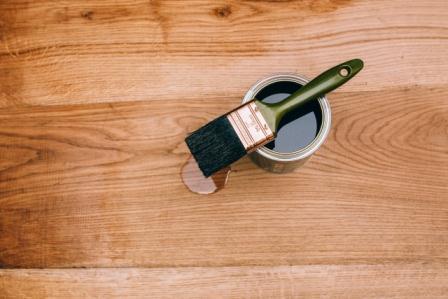Wood is a romantic material. It ages well and gives a rustic and organic appeal. Any wood that has aged naturally will guarantee to add a touch of flair to any home.
But since wood is an organic material, it will be affected by the weather. And if it is not protected and kept in good condition, it will diminish and maybe even break apart prematurely.
Your best fighting chance is to coat surfaces with the right kind of wood oil. It will help preserve the beauty as well as protect it for ages to come.
Knowing the right oil and how to use them will prove beneficial to your furniture, surfaces, and even sidings.
What Is Wood Oil?
This oil is used for decoration and protection as opposed to motor oil, which is used for lubrication.
It protects the surface by coating and penetrating the wood that replenishes the natural oil of the wood, which can be lost due to age, weathering, and general wear and tear from use.
By applying the natural oil, you can bring back the natural beauty of the wood as opposed to varnish that just colors it. You also protect the surface from further damage because the film of oil on the surface will give the right protection for the wood.
Different Types of Wood Oil
There are different types of wood oil, as there are different wood surfaces that have varying requirements. While some oils can be applied to most types of wood, the right wood oil will render the best protection and revive the wood and furniture most effectively.
1. Danish Oil
This type of oil is best for new and untreated surfaces. To get the best result for this, add one coating per day, allowing the previous coat to fully dry up. This will result in a durable coating.
2. Hard Wax Oil
Use this oil if you want to get natural color and grain. It also offers protection against spillage and scratches.
3. Linseed Oil
Linseed oil is great for decorative surfaces. It is famously used in cricket bats and other wooden surfaces. You will need to reapply this to replenish the look. So, it’s not recommended for external surfaces.
4. Mineral Oil
Woodworkers are familiar with mineral oil. It is used for treating wood. And since it washes off and doesn’t leave a film on the wood, it is great for kitchen utensils like chopping boards and wood crockery.
5. Teak Oil
As opposed to mineral oil, teak oil is generally used for external structures. It has properties that protect against UV rays and water stains and, at the same time, revives the wood and accentuates the grain and patterns on the wood.
6. Tung Oil
Also known as China wood oil, it has a plastic-like clear coating when it dries. Considered as one of the finest and possessing the most natural finish on wood, it is usually used on printing ink, oil paintings, and guitars.
Difference Between Wood Oil and Varnish?
Both wood oil and varnish offer protection for wooden surfaces.
The most notable difference between the two is the amount of penetration they have on wood.
Wood oil, since it has a different consistency, can penetrate deeper into the wood. It does not just cover the surface with a film of oil, it also replaces the natural oil of the wood. This allows for a more obvious show of grain and beauty of the wood.
On the other hand, varnish may be a better choice if you are coating something like hardwood floors because of how hard it becomes when it fully dries. A high-traffic area will benefit from varnish because it will protect it from impacts, scratches, and doesn’t easily peel away.
As a rule of thumb, if you want the best protection for wood surfaces, consider the way it will be used and how much protection it needs on a daily basis.
Can I Varnish Over Wood Oil?
In most cases, you can varnish over woods. The main thing to look out for is compatibility. As a general rule, oil will never mix with water.
In essence, you want an oil-based varnish on a surface that has been coated with wood oil.
You have to remember, though, that water-based varnish will not adhere to any wood that has oil on it. But there are some exemptions. To be sure, brush a small amount of water-based varnish to the surface and see if it adheres completely or just slides off.
If you really need to apply varnish, sand down the surface until no more oil is left on the wood.
Can I Use Any Oil on Wood Furniture?
Furniture needs special attention when applying oil because you need to retain its natural beauty as well as protect it from daily wear and tear from usage.
Oiled wooden furniture will have a natural sheen that will give it a great appeal and protect against weathering. But you can’t always oil them. There are a few exemptions you have to keep in mind.
- If the furniture is painted, the paint will not let the oil seep into the wood, and thus, it will just waste your time and effort.
- In the case of unfinished wood, it has to be treated first before applying oil. This will enhance the effect of the oil.
- For very old and weathered wood, you may need to replace the wood altogether if the wood is too dried out and has lost its luster.
Tips for Using Wood Oils Effectively
You can’t just pour oil onto the wood. There are some things you need to do to make it look great and have the best effect on the surfaces you are applying on.
1. Clear the Surface
It is always best to start without any foreign material on the wood. Use a clean damp cloth to clean out the wood and then let it dry.
2. Stain Before Oiling
Here’s what will really make your wood stand out. Use a water-based stain before oiling the surface. Doing this will help make the grain of the wood pop out and prepare the wood for oil. Plus, if you use an oil-based stain, it will prevent the wood oil from penetrating all the way, which will make your effort become moot.
3. Apply a Generous First Layer
Since it is the “foundation” of the following coats, make sure that it will cover most of the surface.
4. Let It Cure
Depending on the formulation of the oil you are using, make sure to follow the instructions for drying completely to get the best results.
Conclusion
Wood oil is a good option for any homeowner who wants to protect their wooden furniture, fences, hardwood floors, and sidings from damages, weather effects, and natural aging. And aside from protection, it will also provide great aesthetic appeal and natural look when applied the right way.

 April 26, 2020
April 26, 2020  6 Min
6 Min  No Comment
No Comment 




















